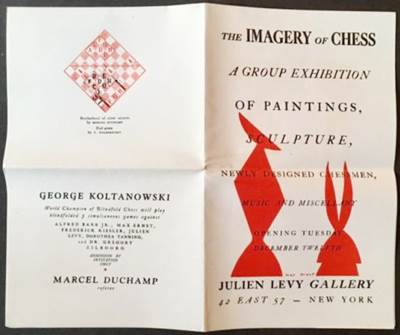The Imagery of Chess, New York 1944
Continuing this blog's eight-and-a-half year series on Top eBay Chess Items by Price (March 2010), in the previous post, Chess with Two Cardinals (August 2018), I wrote,
This month my short list had only one item, but it was not short on quality.
This month I had well over a half dozen items on the short list and it was even longer on quality. The item pictured below relates to The Imagery of Chess, St. Louis (August 2017). Titled 'Marcel Duchamp, Max / Imagery of Chess A Group Exhibition of Paintings Sculpture', it sold for US $500.00, 'Best offer accepted'.

The auction listing included an uncommonly detailed description of the item on sale:-
The Imagery of Chess: A Group Exhibition of Paintings, Sculpture, Newly Designed Chessmen, Music and Miscellany
Author: Marcel Duchamp, Max Ernst
Publication: New York: Julien Levy Gallery, 1944
Binding: Single sheet
Condition: Fine
Description: A wonderful -- and uncommon -- piece of chess ephemera, the original announcement for the December 1944-January 1945 exhibition, which was both published and hosted by the formidable Julien Levy Gallery of New York. Marcel Duchamp, widely known as a passionate, highly accomplished chess player in his own right, designed the layout for the announcement and Max Ernst illustrated the title page, with its bright-red chessmen.
The announcement is made up of a thick single sheet, folded into fourths. On the first verso is a manifesto called "On Designing Chessmen", calling for the improved design of chess pieces over the French and the Staunton sets. And, opposite this, is the list of the 32 contributing artists in the show, the number 32 having been chosen by Duchamp to match the number of chess pieces on the board.
Included among the 32 artists are Andre Breton, John Cage, Alexander Calder, Marcel Duchamp, Arshile Gorky, Man Ray, Robert Motherwell, Isamu Noguchi, Yves Tanguy, etc. And finally, on the last verso is an artistic, fanciful image of a chess set called "Brotherhood of sister squares" by Marcel Duchamp and "End game" by V. Halberstadt. And below this, an announcement that "GEORGE KOLTANOWSKI World Champion of Blindfold Chess will play blindfolded 5 simultaneous games against Alfred Barr, Jr., Max Ernst, Frederick Kiesler, Julien Levy, Dorothea Tanning and Dr. Gregory Zilboorg -- Admission by Invitation Only -- MARCEL DUCHAMP referee".
The show ran from Dec. 12th 1944 thru Jan. 31st 1945 and the announcement is in pristine condition. Crisp and bright and fresh as the day it was issued almost 75 years ago. In fact, this copy is from Julien Levy's estate in Bridgewater, CT.
On the page 'On Designing Chessmen', an unnamed writer said,
The standard chess sets now in use, the FRENCH set and the STAUNTON, are both somewhat confusing in the similarity and intricacy of their forms. In the French set for example, the Bishop is a little Queen and the pawn a little Bishop. Cannot a new set be designed, that is, without a too radical departure from the traditional figures, at once more harmonious and more agreeable to the touch and to the sight, and above all, more adequate to the role the figure has to play in the struggle? Thus, at any moment of the drama its optical aspect would represent (by the shape of the actors) a clear incisive image of its inner conflicts. In the complicated modern game the figures should inspire the player instead of confusing him.. They should whisper to him at the right moment: "Move now to QB4. ... Break through the center. ... Pin the Knight. ... Let me win a piece. ... We can exchange Queens, the pawn will be metamorphosed into a new Queen. ... to mate the King.
And they should never make a MISTAKE.
For another example of Duchamp connecting the world of chess with the vastly larger world of art, see, A Six-Figure Chess Item at Auction (November 2017).




No comments:
Post a Comment